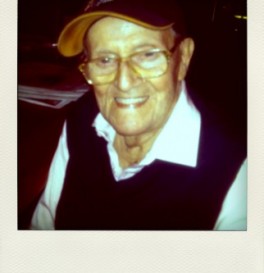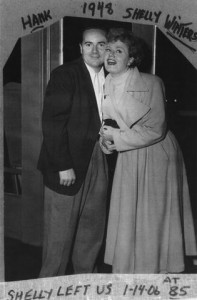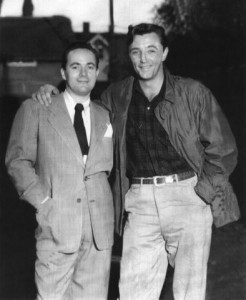
Venue
The H.M.S. Bounty3357 Wilshire Boulevard
Los Angeles, C.A.
————————–
The Tab
(1) Old Fashioned————————–
$4.50 + tip
“I don’t know what I’m doing here. It’s ridiculous,” says Hank Sievers. Hank’s objection isn’t to the venue. We’re at the H.M.S. Bounty, an old-school bar and eatery on the ground floor of the Gaylord apartments on Wilshire. “When I go to bed at night I don’t expect to wake up in the morning. I really don’t. Most people die in their sleep.” I should mention he’s a few days shy of 92.
Hank (no “Mr. Sievers” for him) worked at the Bounty for seven years before retiring in 1991, ending nearly five decades of bartending, and he still shows up on most Saturday afternoons. He seems at home here, even if I’m the only one nursing a drink-an Old Fashioned on the rocks. In honor of my visit, Hank has brought along a collection of photographs and clippings to prompt, and authenticate, his reminiscences.
“What does that say?” Hank says, handing me a black-and-white photograph of Marilyn Monroe in a white dress, sitting with friends and smiling brightly. I read out Hank’s caption, inked in black capital letters: “AND WE THOUGHT SHE WAS A BLONDE!” Never mind the explanation. Zócalo is a family outfit.
Cut to Karlheinz Sievers as a young kid in Hamburg, Germany at the height of the Weimar Republic’s hyperinflation.
“I’d tell my parents, ‘Give me some money to go the movies.’ It must’ve been 20,000 marks, just to go the movies,” Hank remembers. “So they’d put it in a box.”
Hank’s family moved to the United States, settling in Omaha, Nebraska, in time for young Hank to shake Charles Lindbergh’s hand when he came through town. Before long, the family had moved to Los Angeles, where Hank’s father found a job as a cook at a hotel. Sievers was on hand for the opening of the Santa Anita racetrack in 1934. He leans down so that I can see his Santa Anita-emblazoned baseball cap.
Onward to Chicago, where a 15-year-old newspaper boy took a job hawking the not-yet-bankrupt Chicago Tribune.
“I’m on a corner on Fullerton,” Hank remembers. “Four guys in a car drive up. ‘Give us a Tribune, kid!’ I say ‘Sure,’ hand them two. Then I say to myself, ‘Oh shit, this is the guy whose picture is on the front page.’”
The man gave Hank fifty cents, and Hank kept his observation to himself. “I didn’t say to him ‘Hey you’re on the front page!’ You gotta be smart in Chicago. The next day, I’m on the same corner, and I hear, ‘Bang! Bang! Bang!’ And I run across the street. And there he is. Dillinger. Dead as hell.”
Hank worked odd jobs in Chicago, including a stint at a club where he met a young Frank Sinatra. “When the bartender wasn’t looking I’d get him a drink,” Sievers says. Decades later, once in Beverly Hills, another time in Palm Springs, Hank would go out with friends and ask for a check, only to be told, “You’re guests of Mr. Sinatra.”
Another Chicago snippet from Hank’s off-the-cuff memoir: “I voted five times for Roosevelt. Got five bucks each time. 1940. Same election. Chicago!”
Lindbergh, Sinatra, Dillinger—I’m noticing an unmistakable Forrest-Gump quality to the Odyssey of Hank so far. With World War II looming, I’m waiting for him to talk about playing badminton with Stalin. But Hank’s wartime tales turn out to be refreshingly prosaic. He joined the Marines after “the goddam war broke out” and was based in California throughout, starting off as a cook. “They made me a sergeant. But I met a nice girl, took her back to camp. Then I became a corporal!”

With the war behind him, Hank settled into the bartending life in California (where his German parents had found jobs working for—you guessed it—Charlie Chaplin). Hank liked the work. He liked meeting people. One day, Humphrey Bogart was looking for a racing tip. Hank, a fan of Santa Anita, gave Bogart a lead that wound up winning Bogart ten dollars and forty cents. When Bogart next showed up at the bar, he yelled, “Hey, handicapper, give us a drink!”
In 1946, when he was 27, Hank went to Las Vegas and tied the knot with a professional ice skater named Grace Marie Monroe. “We got married the day after she was eighteen,” he says, “because I was fooling around with her when she was fifteen, and I didn’t want to go to jail.” They had two children, a son and a daughter, but were divorced a decade later. (Hank’s son is deceased, but he is now a great-grandfather to his daughter’s granddaughter.) Hank never remarried. “If at first you don’t succeed, forget it!”
As the tales multiply and I take in more of my Old Fashioned, I’m starting to devise a Unified Theory of Hank. Perhaps his success as bartender and his longevity stem from the same thing—complete unflappability. For Hank, life happens. He observes and accepts. His thermometer is set to a nice L.A. seventy-two, and it rises or falls at most a few degrees.
Several people stop by our table to pay their respects. Someone shows off a poster she has made in honor of Hank’s upcoming birthday. It says “HANK IS TURNING 92.” Below that: “A dirty old man needs love too.” Hank is pleased. The Bounty, pretty much unchanged since 1948, is clearly Hank’s home these days—a place of soft lighting and red banquettes, with a selection of sandwiches divided into the categories of Captain Bligh and Fletcher Christian. (Captain Bligh likes the burgers; Mr. Christian favors the baked ham.) It’s a place that should have closed long ago but instead stuck around long enough to become hip again.
Hank has had many casual friends over the years, but one close friend was the actor Robert Mitchum. The two men met near the end of the war. Mitchum was working at Lockheed trying to avoid conscription, and Hank was working at a nearby bar. They spent time together almost every week in subsequent years.
“Mitch worked at RKO, under Howard Hughes,” Hank says. “I went over one day to watch him make a movie. Boring! He says, ‘Go over to my room and wait for me. I’ll be through here in a minute.’ I say, ‘Any vodka in there?’ He says, ‘Yeah.’ So I pour myself a drink and he comes in. Pretty soon there’s a knock on the door. ‘They’re ready on the set, Mr. Mitchum.’ He says, ‘Go fuck yourself.’ Then there’s another knock on the door. I say, ‘I’ll answer this time.’”
It was Ava Gardner, who, at the time, was Howard Hughes’ girlfriend.
“Mitch says, ‘Oh, hi sweetheart, come in!’” Hank recalls. “She left twenty-three hours later.”
I decide to draw the curtain at that point in the story.
When Hank hands me a photograph of himself with Mitchum, it’s hard to immediately discern who’s the movie star. Hank, slightly shorter than Mitchum, looks handsome and muscular, and he’s dressed in a light suit with a short black tie. I ask if he was ever a brawler in his younger days. Never, he says. (Good-otherwise, it’d blow up my newfound Theory of Hank.) There’s still a bit of dapperness to Hank, though. Today, he sports a pink shirt and a blue sweater vest.

In the early 1950s Hank got hired as head bartender at the Saratoga, a bar on Sunset, and stayed on for a couple of decades.
Motion picture stars liked to go to the Saratoga. So did directors. The Director’s Guild was across the street. Everyone knew Hank, and he got the nickname Louella, after the famous gossip columnist Louella Parsons. “If anyone wanted to know anything about the movies, they could go to Hank,” he says.
One memory that makes Hank wince – the only one, come to think of it – is of Johnny Weissmuller, who was famous for playing Tarzan. “Johnny Weismuller always thought he was Tarzan,” Hank says. “And he’s married for the fourth or fifth time to a pro golfer’s daughter. And what a doll! I mean a beautiful broad. She comes in. He’s been there. He’s had eight or ten already. She says, ‘Come on John. Let’s go.’ He says, ‘No, I’m staying here with Hank.’ I’ve never been so embarrassed in my life.”
Nevertheless, the story of Weissmuller has a happy ending, sort of. “He had ten more drinks after that. He could drink and never got out of line. He was a great drinker. I introduced him to his last wife. And she took him down to Mexico and he lived to be 80 years old. How about that?”
The good times at the Saratoga didn’t last forever. The late ’60s weren’t kind to the neighborhood. “The hippies came. They ruined the whole strip,” Hank says with a regretful shake of the head. “It was just awful. They went into joints, and they got drunk and out of line, and they’d ask everybody for money in the streets. All the way up the strip-all these places closed.”
The Saratoga eventually closed its doors, and Hank found a job bartending at the Bull ’n Bush restaurant on 6th Street and Kenmore. When it closed in the early 1980s, Hank tended bar at the Bounty until his retirement at age 72, in 1991. Despite his Saturday visits to the Bounty, he stays away from the hard stuff these days, especially after suffering a broken hip last year.
Why did he stay in the bartending business as long as he did? “I like to be around people,” he answers. “I was a famous bartender. People said ‘Let’s go to the Saratoga. Let’s go see Hank.’” He adds, “Everybody trusts bartenders. I don’t know why, but they do.”
I try to press him a bit on the meaning of his odyssey, to discern the takeaway on this remarkable life, but that’s not how Hank rolls. He indicates we’re done and gets up from our table to resume his place, and his soft drink, at the bar.
I look at the clock and judge that sufficient time has elapsed since I drank my Old Fashioned to allow me to drive home. (Johnny Weissmuller I am not.) Hank may not have taken me deep into his soul, but he tells a hell of a story. I can see why Tarzan enjoyed drinking with him.



